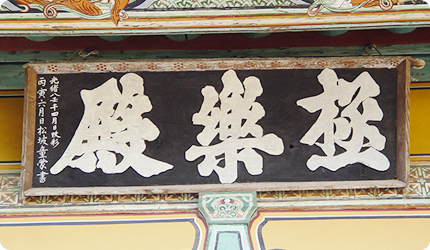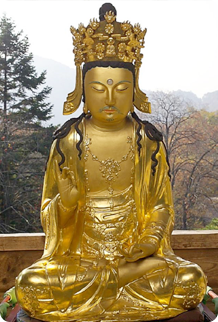Buddhist Mountain Monasteries in Korea
Bongjeongsa Temple
Bongjeongsa Temple
Introduction
Natural Environment
History
Temple Layout
Cultural Properties
Information
History of Bongjeongsa Temple
-
- Bongjeongsa is said to have been founded in 672 (12th year of King Munmu’s reign), but the information regarding the founder varies across the records.
According to Yangbeopdang-jungsu-gi, the founder of Bongjeongsa is said to be Great Monk Uisang, while the Sangnyangmun records of Geungnakjeon state that Great Monk Neungin was the founder.
These two records dating from the Joseon Dynasty are the oldest documents regarding the history of a temple, and the records regarding the foundation have been adapted into mythical tales. Great Monk Neungin was a disciple to Great Monk Uisang, and according to Samguk-yusa (Legends and History of Korea’s Three Kingdoms), the temple that Great Monk founded first upon returning to the homeland was Buseoksa. Since Bongjeongsa Temple was actually founded in 672, 4 years before the founding of Buseoksa, it is most likely that the founder was Great Monk Neungin. -
 Geuklakjeon Hall of Bongjeongsa Temple a plaque
Geuklakjeon Hall of Bongjeongsa Temple a plaque
- Bongjeongsa is said to have been founded in 672 (12th year of King Munmu’s reign), but the information regarding the founder varies across the records.
According to Yangbeopdang-jungsu-gi, the founder of Bongjeongsa is said to be Great Monk Uisang, while the Sangnyangmun records of Geungnakjeon state that Great Monk Neungin was the founder.
-
-
 Wooden statue of the seated Avalokitesvara - Cultural Heritage Administration of Korea
Wooden statue of the seated Avalokitesvara - Cultural Heritage Administration of Korea
- There isn’t any accurate information on the history of the temple following its establishment; however, based on the extant temple buildings, it is clearly evident that it was held in high regard in both the Goryeo and Joseon dynasties and carried on the lamp of Dharma (Buddha's teaching) to lift the darkness from the world.
Some of the artifacts dating from the Goryeo Dynasty include the wooden statue of the seated Avalokitesvara (Treasure No. 1620) and Geungnakjeon (National Treasure No. 15).
Based on Daeungjeon-gwaneum-gaegum-hyeonpan and Jungsu-wonmun (1753), it is known that the wooden statue of the seated Avalokitesvara was first constructed in 1199 (2nd year of King Sinjong’s reign) and repaired between 1363 and 1364, and 1751 and 1753.
In terms of its sculpting style, the wooden statue of the seated Avalokitesvara is comparable to the wooden statue of the seated Avalokitesvara of Bogwangsa Temple in Andong, which is estimated to have been created between the end of the 12th century and the early 13th century, and the wooden statue of the seated Amitabha of Gaesimsa Temple in Seosan.
Accordingly, it is highly possible that the statue was created in 1199, as recorded in Daeungjeon-gwaneum-jungsu-hyeonpangi.
In the case of Geungnakjeon, a Sangnyangmun document was discovered in the process of repair in 1972. The document states that the roof was repaired in March 1363 (12th year of King Gongmin’s reign) in the late Goryeo Dynasty, and based on this record, it is believed that the building must have been built in the mid-Goryeo Dynasty at the latest.
Bongjeongsa Temple remained undamaged, even during the Japanese invasion of Korea in 1592, and repair work has been performed multiple times to keep their original appearances and characteristics intact.
-
Chronological Table
| Time Period | Description |
|---|---|
| 672 | Bongjeongsa Temple is founded by Great Monk Neungin, a disciple to Great Monk Uisang |
| 1199 | Wooden statue of the seated Avalokitesvara is created |
| 1363 | The roof of Geungnakjeon is repaired (Sangnyangmun discovered during the deconstruction and restoration work in 1972; Geungnakjeon recognized as the oldest wooden building (built around 1200) |
| 1516 | Toegye Yi Hwang stays at the temple to study, with his cousin Yi Su-geum; Myeongokdae in the valley below Iljumun Gate was called Naksudae but the name was changed by Yi Hwang |
| 1616 | Gogeumdang is repaired and Chukdam, former abbot of Yongsusa, rebuilds Daejangjeon in March 1625 |
| 1712 | Buddhist altar painting of Daeungjeon is created |
| 1809 | Monks Daeyeong, Jaeik, Jiwon, Seosaeng and others join forces to rebuild Geungnakjeon and Daeungjeon |
| 1863 | Temple buildings are partially repaired with donations from Deungchokgye(fraternity) |
| 1882 | Signs are repaired |
| 1969 | Gogeumdang is deconstructed and restored |
| 1972-1975 | Geungnakjeon is deconstructed and rebuilt |
| 1999 | Bongjeongsa is visited by Queen Elizabeth II of England |
| 2000 | Sangnyangmun is discovered during the repair of the Daeungjeon roof, and a document written in ink stating that the temple was founded in the late Goryeo Dynasty is found under the wooden altar of Daeungjeon |
